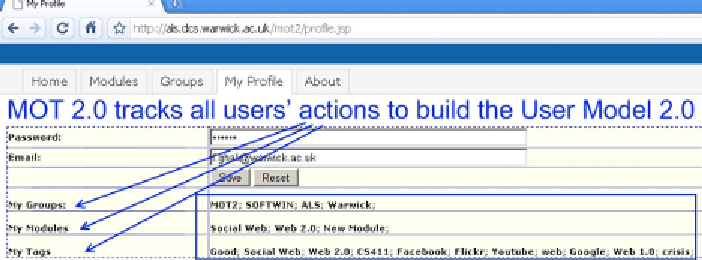Information Technology Reference
In-Depth Information
Figure 3. MOT 2.0: User model 2.0
Figure 4. MOT 2.0: Adaptive reading
following implementation round, we plan to both
extend the implementation to more fully reflect
the flexibility allowed by these content-based
layers, as well as apply other adaptive strategies,
as the specification of the strategy will be external
and exchangeable, according to the LAG model
(Cristea & Verschoor, 2004).
Figure 5 describes the
social annotations
for
the actual lesson based on the user's privileges
for the selected group/course. These social ac-
tivities include rating the content of the item,
feedback, and tagging items with a set of keywords
(such as defined by definition 3). They are captured
and added to the user model in order to provide
more adaptive features, and thus more flexibility
in the adaptation process. In such a way, the rec-
ommended content is based not only on the
background and trace of the user, as in classical
adaptive hypermedia, but also on social activities,
e.g., on how popular the item is with other read-
ers, or on who recommends it (trusted users
versus unknown users). This also is used in sce-
nario 1 for recommended content, as well as in
scenario 2 on grouping the work for students.
Figure 6 shows how the
adaptive authoring
works, by displaying other related recommended
courses which can be used in creating the course.
Scenario 5, with Helen putting together a course
based on system recommendations, is directly
reflected here. Whether or not something is pre-
sented or is based on the pedagogical adaptation
strategy, which influences the presentation
model (e.g., a Boolean value overlaid over an
item that is to be shown is commuted to True). In


Search WWH ::

Custom Search